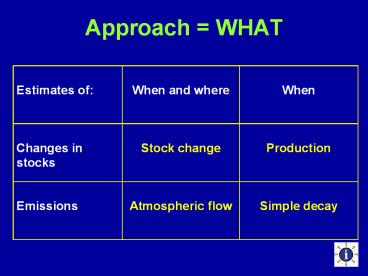Approach = WHAT PowerPoint PPT Presentation
1 / 10
Title: Approach = WHAT
1
Approach WHAT
Estimates of When and where When
Changes in stocks Stock change Production
Emissions Atmospheric flow Simple decay
2
Revised IPCC 1996 Guidelines
- annual biomass growth versus annual harvest,
including the decay of forest products and slash
left during harvest - Atmospheric impact SF DF LM DP
- Where
- SF sequestration in the forest
- DF decay of residues in forest
- LM losses at mills during processing
- (burnt to waste or used for energy)
- DP decay of products
- (related to lifetime in use or in disposal
sites) - Atmospheric impact SF DF Harvest
- only if instant oxidation on leaving the forest
3
Stock changes or Emissions
Forests
Products
ARe-forestation
CDM
Forest management
Deforestation
non-Kyoto countries
Pre 1990
Stock change In all forests Resulting from
activities since 1990 Sinks In all
forests Resulting from activities since
1990 Within national boundaries from
activities within national boundaries
Stock change In all products In products
manufactured since 1990 In products resulting
from activities since 1990 Sources from All
harvested wood burning and decay Harvested wood
since 1990 Harvested wood resulting from
activities since 1990 Within national
boundaries (incl import-export) From domestic
activities (excl import-export)
4
Simple Decay approachstocks resulting from
activities
Stock
Source products
Sink
Tier 1 at harvest Tier 2 default
categories and lifetimes Tier 3 improved
categories and lifetimes
Source residues
Time
5
Consistency
- Residues oxidise immediately or decay
- Reversal of sink when it occurs
- Applicable at project or national scale
- Consistent reporting and accounting
- Desirable outcomes (submissions)
6
Sustainable Forest Management
Stock
Sawlog regime
Pulplog regime
7
Bioenergy and Processing
- Emissions remain responsibility of producer
- no change to bioenergy or trade impacts
- Improved inventory accuracy
- Favour long rotations for sawlogs
- Encourage high conversion (to product) efficiency
- Sawmills least energy intensive
- Opportunity for energy exporting sector
- Including waste disposal sites reduces incentive
for bioenergy
8
Inventory impact
annual biomass growth versus annual harvest,
including the decay of forest products and slash
left during harvest
Emissions (during the year) Emissions (during the year) Emissions (during the year) Emissions (during the year) Emissions (during the year) Stocks (end of year) Stocks (end of year) Stocks (end of year) Stocks (end of year) Stocks (end of year)
Yr Growth Harvest 1 2 3 4 5 1 2 3 4 5
1 100 100 50 5 5 5 5 50 45 40 35 30
2 100 100 50 5 5 5 50 45 40 35
3 100 100 50 5 5 50 45 40
4 100 100 50 5 50 45
etc 100 100 50 50
Emit/year Emit/year 50 55 60 65 70 Total 50 95 135 170 200
change 50 45 40 35 30
Production Approach growth harvest hwp stock
change Simple decay growth - emissions
9
Inventory impacts
Harv Emissions (tC) Emissions (tC) Emissions (tC) Emissions (tC) Emissions (tC) Emissions (tC) Emissions (tC)
Year Type tC 1 2 3 4 5 6 7
1 Pine 100 50 10 10 10 10 10
1 SRF 100 50 50
1 Defor 100 100
Total 200 200 60 10 10 10 10
2 Old 60 10 10 10 10
2 Sawn 100 50 10 10 10 10 10
2 Pulp 100 50 50
Total 200 160 70 20 20 20 10
10
Conclusions
- Simple Decay approach
- Described in 1996 Guidelines
- Satisfies Marrakesh principles
- Simple to apply (all Tiers)
- National reporting and accounting
- Scaleable
- Promotes sustainable forest management
- Promotes bioenergy
- Management of products is separate issue

